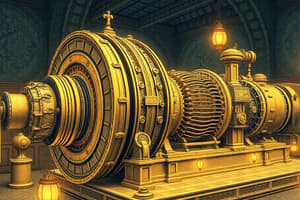Podcast
Questions and Answers
What is one significant drawback of DFIGs related to managing reactive power in the grid?
What is one significant drawback of DFIGs related to managing reactive power in the grid?
The power electronic converter in a DFIG must actively manage reactive power, which is a challenge for maintaining stability.
Explain how the rotor circuit of a DFIG contributes to parasitic losses.
Explain how the rotor circuit of a DFIG contributes to parasitic losses.
The rotor circuit in a DFIG is connected to a converter, which leads to increased copper losses due to the electrical resistance of the conductors.
What is a significant limitation of DFIGs in regards to their ability to handle grid faults?
What is a significant limitation of DFIGs in regards to their ability to handle grid faults?
DFIGs have reduced capability in maintaining operation during grid faults compared to other types of generators.
How does the control complexity of DFIGs impact their implementation?
How does the control complexity of DFIGs impact their implementation?
Describe a specific cost associated with incorporating DFIGs into the grid.
Describe a specific cost associated with incorporating DFIGs into the grid.
What is the primary role of the power electronic converter in a DFIG system?
What is the primary role of the power electronic converter in a DFIG system?
Explain the advantage of variable speed operation in DFIG wind turbines.
Explain the advantage of variable speed operation in DFIG wind turbines.
How does a DFIG achieve efficient operation compared to other induction generator technologies?
How does a DFIG achieve efficient operation compared to other induction generator technologies?
Explain the relationship between the rotor speed and the slip in a DFIG.
Explain the relationship between the rotor speed and the slip in a DFIG.
What are two main disadvantages associated with DFIGs?
What are two main disadvantages associated with DFIGs?
Describe how DFIGs contribute to reduced stress on components and grid connections compared to full converter systems.
Describe how DFIGs contribute to reduced stress on components and grid connections compared to full converter systems.
Compare the cost-effectiveness of DFIGs to full converter systems in wind turbine applications.
Compare the cost-effectiveness of DFIGs to full converter systems in wind turbine applications.
Explain why DFIGs are considered sensitive to grid imbalances and disturbances.
Explain why DFIGs are considered sensitive to grid imbalances and disturbances.
Flashcards
Voltage/Frequency Variations
Voltage/Frequency Variations
Fluctuations in voltage or frequency that affect grid efficiency.
Reactive Power Management
Reactive Power Management
The process of managing reactive power to maintain system stability.
Parasitic Losses
Parasitic Losses
Unwanted energy losses, particularly in rotor circuits connected to converters.
Fault Ride Through Capability
Fault Ride Through Capability
Signup and view all the flashcards
Control Complexity
Control Complexity
Signup and view all the flashcards
DFIG
DFIG
Signup and view all the flashcards
Rotor Slip
Rotor Slip
Signup and view all the flashcards
Variable Speed Operation
Variable Speed Operation
Signup and view all the flashcards
Power Electronic Converter
Power Electronic Converter
Signup and view all the flashcards
High Efficiency
High Efficiency
Signup and view all the flashcards
Cost-Effectiveness
Cost-Effectiveness
Signup and view all the flashcards
Complexity in DFIG
Complexity in DFIG
Signup and view all the flashcards
Grid Sensitivity
Grid Sensitivity
Signup and view all the flashcards
Study Notes
DFIG Principle
- DFIGs (Doubly-Fed Induction Generators) are a type of induction generator where the stator connects to the grid and the rotor to a converter.
- This design enables efficient power extraction from variable-speed wind turbines, maintaining constant voltage and frequency at the generator-grid interface.
- The rotor winding is connected to a power electronic converter, controlling slip power flow.
- The converter injects or absorbs reactive power to adjust slip, enabling variable rotor speeds.
- The converter's key function is controlling rotor slip (difference between synchronous and mechanical speeds).
- Adjusting slip precisely controls power transfer between rotor and stator.
DFIG Advantages
- Variable speed operation: DFIGs maximize energy capture from variable-speed wind turbines, improving on fixed-speed generators' limited capture at varying wind speeds.
- High efficiency: Variable speed enables improved energy capture at sub-optimal wind speeds. High efficiency also exists at low wind speeds compared to other induction generator types.
- Cost-effectiveness: Though the power electronics component adds cost, DFIGs are often more cost-effective than full converter systems in many wind turbine applications.
- Reduced component stress: Decoupling of wind turbine speed and grid frequency reduces stress on components and grid connections compared to full converter systems.
DFIG Disadvantages
- Complexity: The power electronic converter adds complexity and cost, necessitating a sophisticated control system.
- Efficiency losses: Power electronic converters aren't 100% efficient, causing power losses, more significant at lower operating speeds.
- Converter size/cost: Power electronic converters can be large and expensive.
- Grid sensitivity: DFIG performance is affected by power system imbalances and disturbances. Grid voltage/frequency fluctuations, and current variations, negatively impact DFIG efficiency & stability.
- Reactive power management: The converter actively manages reactive power, presenting challenges to stability.
- Maintenance: Specialized converter maintenance is costly.
- Parasitic losses: Increased copper loss in the rotor circuit due to converter connection.
- Limited fault ride-through capability: DFIGs have reduced ability to maintain operation during grid faults.
- Control complexity: Sophisticated programming and monitoring systems are needed for speed & power output regulation.
- Reactive power compensation cost/size: Additional equipment for voltage/frequency maintenance increases cost and size.
Studying That Suits You
Use AI to generate personalized quizzes and flashcards to suit your learning preferences.

